07.28.2011 | 11:44 am
Cast your mind back. Way back. Think about PowerBars. No, not the 12 different kinds of PowerBars you can buy today (ProteinPlus, ProteinPlus Reduced Sugar, ProteinPlus Reduced Sugar With Extra Calcium, ProteinPlus Reduced Sugar With Extra Calcium and Caffeine and Just a Hint of Cheez Wiz, among others).
The original PowerBar. The PowerBar that required a full-body workout to tear a piece off, and resulted in aching jaw muscles if you tried to chew it. The PowerBar that you could use, in a pinch, to repair a broken bike frame.
I don’t know if those kind of PowerBars were where energy food started, but they’re the first energy food I remember.
Then Clif Bars came along, and I was hugely relieved, because here was something I could stuff in a jersey pocket, but which didn’t — and I am not exaggerating here — hurt to eat.
And then PowerBar came out with PowerGel: 100 calories you could choke down nearly instantly, provided you didn’t mind consuming something with the consistency of toothpaste and the sweetness of concentrated stevia.
At which point Clif came out with the original Clif Shot, which came in what looked like toothpaste tubes and came in several flavors, all of which tasted exactly like molasses straight from the bottle.
Epiphany
Those were the dark years. But they were necessary; you’ve got to start at a trailhead if you’re going to go down a trail.
And somewhere on that trail, maybe someone had a crucial epiphany: It doesn’t matter how many nutrients an energy food has if, while riding, the thought of eating said energy food triggers your gag reflex.
Or maybe the epiphany was more succinct: People like food that tastes good.
And that’s where Honey Stinger — a little energy food company in Steamboat Springs, CO — comes in.
And I shall now spend the rest of the post talking about how much I love — yes, love — what they make.
Full Disclosure
OK, actually, before I talk about how much I love Honey Stinger, I’d better do the full disclosure thing: Honey Stinger sends me food for free.
However, this full disclosure should come with an explanation.
Honey Stinger sends me food for free because I contacted them and told them how much I love them and that more than anything else in the world, I would love to have an ongoing supply of Honey Stinger food, both for myself and to hand out to other riders, acting as a kind of “First Hit’s Free” kind of sales guy for them.
In other words, I’m not shamelessly plugging Honey Stinger because they give me free stuff. Rather, Honey Stinger gives me free stuff because I begged them to and happen to be an award-winning superstar cycling ultra-megablogger.
Or more to the point: I’m not selling out; I was already sold.
 OK, Now On With the Honey Stinger Love Fest
OK, Now On With the Honey Stinger Love Fest
The most important thing you can do today is to find where you can buy Honey Stinger Waffles (you can also get them online), then pick some up, and then go out on a ride and try one.
And it’s very important you try it while you are on a ride or you will mistakenly think you have just had a really delicious treat, and that — hey, why not? — you’ll have another. And so forth, until you’ve eaten all of them.
So you’ve been warned.
Here’s what Honey Stinger Waffles have got going for them:
- They taste good. Seriously, like eat-them-recreationally good. Not as in “This is OK for on a bike but I wouldn’t eat it otherwise” good.
- Texture-licious. Crisp waffle on the outside. Honey on the inside. Yum.
- They are flat. There’s something to be said for energy food that goes into the back of your jersey without bulging it out. Stylie.
- They actually give you energy. I’ve been eating these while riding and they work. The Hammer and The IT Guy and Kenny and Heather have all been riding using these too. All agree: these are the real deal. Sadly for me, since everyone’s been snarfing my Honey Stinger Waffles, my supply has run low much sooner than I told the Honey Stinger guys it would, and now I’m going to have to give them a call and ask for more about a month early.
Are the Vanilla or Honey Waffles better? I don’t know. I like both the same. Which is a lot. In fact I’ll say this very quotable thing which I’m sure the Honey Stinger people will find eminently suitable for their marketing materials:
At 160 calories-worth of deliciousness, Honey Stinger Waffles are the best energy food in the whole world.
Elden “Fatty” Nelson
Award-Winning Blogger
www.fatcyclist.com
I like the Honey Stinger Waffles so much, I am now going to spontaneously write a free-verse ode to them:
O Waffle!
Honey Stinger Waffle!
I look at you from afar
Across the room
I would eat you
Right here
Right now
‘Cept I have promised myself
That I would forebear
And not snitch
And otherwise try to be good
So that I do not run out of you
Before my next bike ride.
Alas!
I remain tempted!
And find myself making
Rationalizations and justifications
And well, you know, maybe it’s a good idea
To carbo-load a little
Before I go out riding
In a couple hours
O Waffle,
Honey Stinger Waffle
You were just as delicious
As I remember
And maybe I will have just one more.
Thank you.
 Honey Stinger Energy Chews
Honey Stinger Energy Chews
First off, major props must be given to Clif for inventing (as far as I know; I don’t actually do research or anything) energy chews in the first place. For years, Shot Bloks have been my go-to energy source for long bike rides.
But not anymore.
Honey Stinger Energy Chews are easier to chew, taste better, and are easier to get from the package into your mouth than Shot Bloks.
The Honey Stinger Energy Chews are, in fact, the thing that got me interested in other Honey Stinger stuff in the first place.
They open easily — just tear the package open in one tug with your teeth — and then squeeze the package so that the chews slide into your mouth.
A crude — but easy to learn and master — technique to be sure. But on-bike eating has never been a proper affair.
They’re delicious and soft — they go down quickly and easily, so you can get back to mouth-breathing ASAP.
These come in lots of flavors: Pink Lemonade, Lime-Ade, Fruit Smoothie, Cherry Blossom, Pomegranate Passion Fruit, and Orange Blossom.
My favorite flavor is Orange Blossom. Honestly, I don’t know what the “blossom” part of the name is about, and have to say I avoided these for a while because I thought they would taste like a flower. In reality, they taste like Orange Crush. As they should.
The Hammer’s favorite flavor is Lime-Ade. I suspect this is because she is a caffeine freak.
 Protein Bars
Protein Bars
I’ve really ramped up my protein intake in the past couple of months, and I’m finding that I’m down in weight and riding stronger than I ever have. I dropped fourteen pounds between the beginning of May and the beginning of June. Well, the Honey Stinger Peanut Butta Pro Protein Bar was an important part of that. Specifically, it’s loaded with protein and it tastes pretty much like a giant Reese’s Peanut Butter Cup.
I eat one of these (when I don’t have time or access for the egg whites and avocados) and I stop being hungry.
For smaller snacks, I’ve been eating the Dark Chocolate Mint Almond Protein Bar — if you like mint-chocolate (and I do), you will love it.
 Energy Bars and Gels
Energy Bars and Gels
I know that Honey Stinger actually got their start with honey-based Energy Gels, but you know what? That’s the one thing of theirs I just have not been able to get into. Is that ironic? I don’t know.
Anyway, my ambivalence toward Honey Stinger Gels has to do with a couple of things:
- Honey-ness: These really are pretty much honey, with a little bit of flavoring (except the “Gold” flavor, which is just straight-up honey-flavor). It’s too strong/sweet for me. So sweet they feel like they’re burning the back of my throat. If you love the taste of honey, you’ll be fine with Honey Stinger gels. Otherwise, maybe buy one and try it on a ride before you buy a whole box of them.
- Stickiness: Since these are honey, they’re sticky like honey. Which means that if you don’t execute a perfect open-eat-dispose sequence, you’re going to get honey on your gloves or mouth or in your jersey. So far, I have never executed a perfect open-eat-dispose sequence.
As to the Honey Stinger Energy Bars, well — they’re really good. But they have the “Great defeating the Good” problem: any time I could have one of the bars, I’d rather have one of the Waffles, or a packet of Energy Chews.
And in fact, I believe I will.
Again.
Comments (70)
07.26.2011 | 11:19 am
A Note from Fatty: In the sporadically occasional “The Fat Cyclist Explains” series, I — the Fat Cyclist — explain things. Including, apparently, what seems to be a fairly self-explanatory series name.
One of the very best things about being a beloved Internet cycling celebrity is the fact that, merely by writing about bicycles on a frequent basis, I have become an authoritative expert on everything even tangentially related to bikes. For example, I’m very qualified to tell you what kind of bike you should buy next. I’m perfectly capable of giving you sound advice on bike maintenance and repair, even though I personally take my bikes into the shop for both.
And as a person who constantly battles weight issues, I’m exactly the right person you should go to for nutrition advice.
Thus, today’s question, submitted by me using the pseudonym “Duane,” is as appropriate as it is timely.
Dear Fatty,
I’ve noticed that a lot of cycling computers, GPSs, and ride-tracking applications give you information on how many calories you burned during a given workout. Can you use that data to calculate how much weight loss you should expect?
As always, thank you for writing the best blog that has ever been created in the history of the universe,
Duane
Wow, imaginary person I’m calling “Duane,” thanks for your question! You can in fact use the “calories burned” report from your GPS / bike computer / iPhone app / whatever to accurately project your change in weight. Just remember, there are 3500 calories in a pound, so you just have to do the math.
Sadly, however, that math is not quite as simple as you might think.
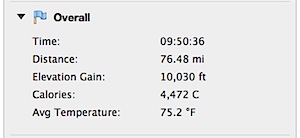 The Law of Extremely Diminishing Returns
The Law of Extremely Diminishing Returns
Suppose you just went on a really long mountain bike ride: 76.5 miles, with more than 10,000 feet of climbing. Your GPS might tell you that you’ve expended 4,472 calories.
So you should have lost 1.28 pounds, right?
Wrong.
Unfortunately, no exercise computer takes into account several critical factors in calculating your calorie expenditure.
Critical Factor 1. Cumulative Time Spent Biking Over The Years
The most important thing your calorie-computing software overlooks is the fact that as you become a more experienced cyclist, you also become a more efficient cyclist. Which is to say that when you first begin cycling, you actually burn way more calories in a workout than the bike computer gives you credit for.
Unfortunately, as you ride more, you’re going to start riding better. You’re going to turn the cranks smoother (smootherly?), more efficiently. You’re going to stop bobbing your head and thrashing your body around during the climbs. Unless you’re Thomas Voeckler, of course.
You’re going to, in essence, go further with less effort.
The following highly-scientific and professionaly-produced chart illustrates this effect by plotting how many calories you can expect to spend when riding 100 miles on your bike, once you factor riding experience in.
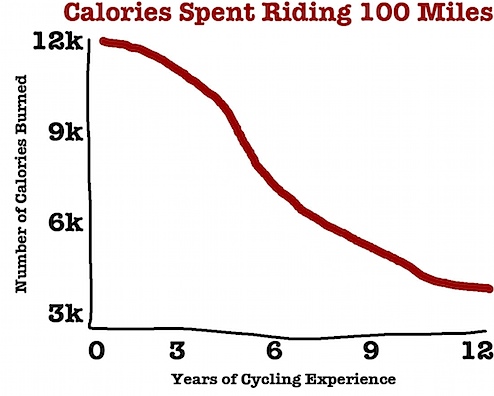
As you can plainly see, by the time you have been riding 12 years, you can expect to expend a scant quarter of the number of calories as you did when you first started riding.
This is, at least in part, why you hear about cyclists going on longer and longer rides as they become more experienced. They have to, just to expend the same number of calories they used to when they went on much shorter rides.
But there’s a vicious cycle at work here. Or a slipper slope. I’m not sure which. Maybe it’s a slippery slope that eventually curves back on itself, becoming a vicious cycle.
Anyway.
The problem — which is either a slippery slope or a vicious cycle — is that as you ride more in order to burn more calories, you gain experience and efficiency, thus making it so that you need to ride yet even still more in order to burn the same number of calories.
And the problem gets worse.
As, over the years, you continue to ride, you burn fewer and fewer calories, until you reach what as known as the Paradoxical Cycling Calorie Cataclysm Threshold (PCCCT, pronounced “pkkkhht”), as shown below:
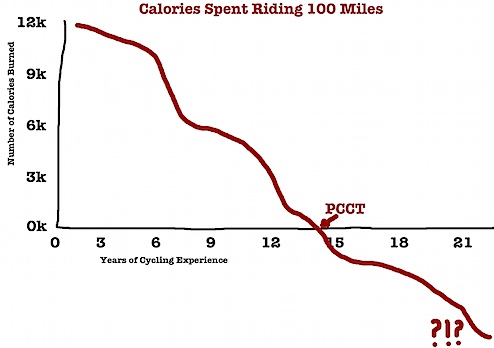
For those who are not quite certain, what you suspect is in fact the case: somewhere around your fourteenth year of riding, you stop burning calories when riding, and begin creating them. In defiance of what scientists know so far about physics, you start creating matter by expending energy.
At which point, the more you ride, the more weight you gain. Unfortunately, the converse — that if you ride less, you start losing weight or at least don’t accrue weight as fast — is not true.
Which is a shame.
Critical Factor 2. The Food Factor
The second factor calorie-counting software doesn’t take into account is the fact that as you ride and (hopefully) burn calories, something mysterious is going to happen to you:
You are going to get hungry.
When this happens, you must choose one of two options:
- Ignore the hunger, causing it to grow exponentially.
- Eat something.
If you choose option 2, you will invariable consume an amount approximately equal to the number of calories you have burned, causing the balance of the universe to be restored, and also causing you to not lose any weight.
If, however, you choose option 1, you will discover that eventually you will be unable to resist the hunger and will eat everything in your fridge, as well as — if you have a key to their house — in your neighbor’s fridge. At which point you will have incurred a calorie surplus equivalent, roughly, to 2.5x the number of calories you have consumed.
But you’ll be eating that during your post-workout high-metabolic recovery window, so those calories won’t really count.
Just kidding! They count even more than normal calories, actually. Because they’re guilty, no self-control calories.
Critical Factor 3. Problematic Calculations
The final factor you need to account for when looking at the number of calories software projects you have expended has to do with the “Fuzzy Logic” algorithms the software uses in its calculations.
What does this mean? Well, in order to give you a real-world assessment of your workout, the software takes your weight, the distance you traveled, the amount of climbing and descending you did, the ambient temperature, the phase of the moon, and several other factors into consideration.
This is when “fuzzy logic” comes into play, which means the software ignores all that data and picks a random number between one and ten thousand, which it then reports to you as the number of calories you have expended.
It’s very useful data, and I recommend you trust it explicitly.
PS: Hey, we’ve got artwork ready to go for the Grand Slam for Zambia: 1000 Bikes, 1000 Lives Changed project. Check it out:
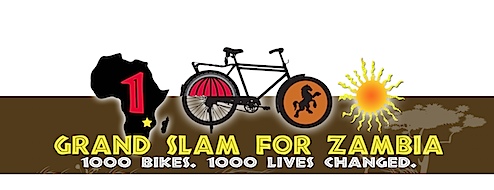
You’ve got to admit: this would be a pretty awesome sticker to have on your bike, and it can be yours if you buy a bike for a kid in Zambia, changing her life in a huge, awesome way. Read here for details of what Johan Bruyneel and I are doing and what you can win, and then go here to enter the contest.
Comments (45)
07.24.2011 | 9:36 pm
I’ve never liked the term “Endurance Race.” I mean, you endure lectures from your boss. You endure piano recitals. You endure watching flat stages on the Tour de France (though I sincerely appreciate ASO’s work at livening those stages up this year by placing invisible obstructions along the course, causing massive crashes to break up the otherwise unendurable monotony).
But long biking races? Well, sure, there are moments when I’m enduring, by which I mean “continuing as if I want to ride, even a big chunk of me would rather stop.”
But mostly, I don’t endure the Leadville 100, or I wouldn’t keep signing up for it (this year will be my 15th consecutive time). I wouldn’t have raced the Kokopelli. I wouldn’t do eight-hour training rides most weekends during the summer.
So here’s the problem: this term “endurance racing” takes an amazing, demanding, beautiful event…and then labels it with its least attractive attribute. I mean, using this technique, Soccer would be called, “Fans Murder Each Other-Ball.” Baseball would be called, “Hardly Anything Ever Happens-Ball.” Running Would be called “Ruining Your Joints.”
Why not call long-distance racing “Seeing a Big Chunk of the World Racing?” Or “Exhibiting Unusual Amounts of Stamina and Cheerful Determination Racing?” Because it’s not really just about enduring. (And don’t go trying to tell me that someone’s already solved this problem by inventing the word “randonneuring,” because that’s just a French word for “riding around with a lot of luggage and pretending you’re not lost.”)
Or at least, that was my perspective until last Saturday.
A Fateful Decision
The IT Guy — The Hammer’s 21-year-old son — has been riding with The Hammer and me a lot lately. That’s because he’s signed up to race the Leadville 100 this August. His first big endurance race.
Last week, for example, he rode Camel Pass. And here he is with The Hammer the weekend before last as we did a mini version of a local epic road ride affectionately known as The Gauntlet (The mini version has “only 78.6 miles / 10,800 feet of climbing; the ultimate version has 96.5 miles / 20,000 feet of climbing).
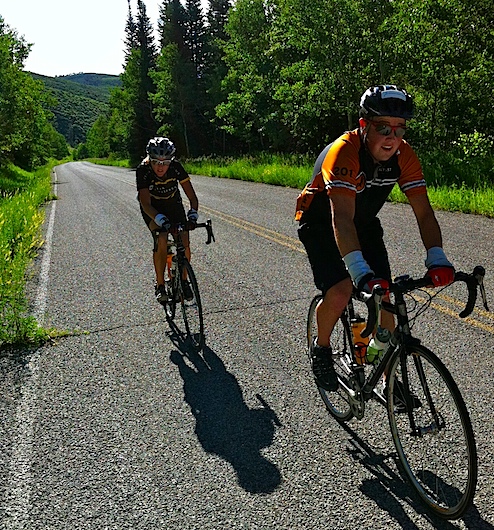
So, you know, he’s been doing a little bit of riding. We have high hopes for him finishing at Leadville.
And with just a few weeks ’til the Leadville 100, we decided it was time to take him out to do a mountain bike ride that really simulated what he’d be experiencing in Leadville: the Pole Line to Guardsman to Corner Canyon loop.
The Hammer and I had ridden it once before, on July 4. It’s a beautiful ride.

Yes, we have views like this from a lot of the rides that start and end at our house. Envy us.
Anyway, the ride’s physically demanding, but not technical. Like Leadville.
There’d be multiple sustained climbs — about 13,800′ worth of climbing throughout the day.
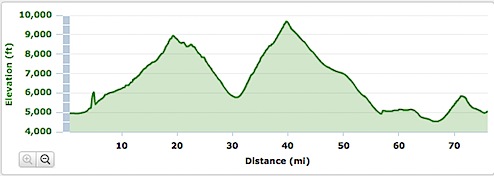
Not too different from Leadville.
And, importantly, there’s one particular beast of a climb — Guardsman Pass — that gets in your head the same way Leadville’s Columbine Mine climb does. Nearly 4000 feet of climbing in under nine miles will do that to you.
Especially that one little section that’s at a 23% grade.
Differences Make a Difference
But The Hammer and I didn’t bring The IT Guy on this ride to shake his confidence. The fact of the matter is, The IT Guy is riding strong; we figured he was ready for this challenge.
But some things had changed since the last time The Hammer and I had done this ride. First, it had gotten warm. Here’s a self-portrait near the summit of Guardsman Pass on July 4:

Now, I didn’t take any photos when we took The IT Guy on this ride just 20 days later, but you’ll have to take my word for it: there is no longer any snow. Because whereas the first time The Hammer and I did this ride the high temperature was 80.6(F), last Saturday it got a little bit warmer.
OK, it got to 109.4(F). But it was a dry heat, and it’s not like we were toiling up a 15% grade on mountain bikes at the time. OK, maybe it was a little like that.
A Quick Aside
Have you noticed that about 35% of all photos of people on the Internet are self portraits with one shoulder in the foreground as they try to point the camera at themselves? The thing about those photos is, they all look a lot alike. Specifically, a head and shoulders shot of a smiling person, getting in the way of the subject matter the smiling person wanted a photo of. For example, here’s a picture of me when I was visiting my sisters in Brooklyn:

And here’s a shot of me on a beach in Hawaii:
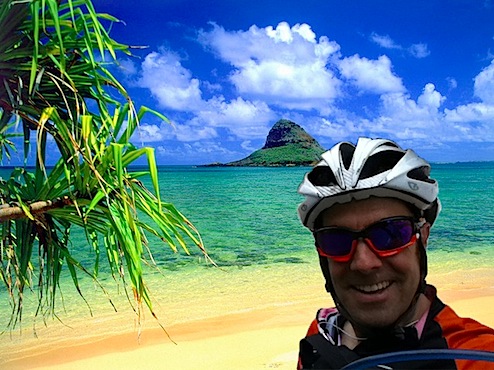
Oh, and me visiting the Late Cretaceous period:
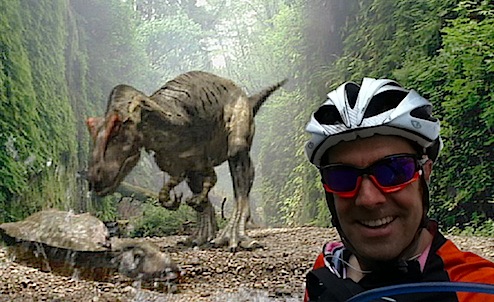
And here’s me hanging out with NYC Carlos at the Davis LiveStrong Challenge a couple weeks ago:
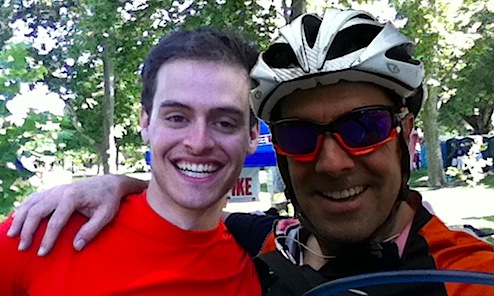
I tell you what: I need to start varying my smile in these self-portraits a little bit. Also, I seem to have sprouted an extra ear in that last photo. I’ll have to see the doctor about that.
OK. Where was I? Oh yeah. The IT Guy. Differences. Impending doom.
The Other Differences
So it was hot. Fine. The other thing that had changed quite a bit in the past few weeks is that the mosquitoes are hungry now. And so are the deer flies, which are just as annoying as mosquitoes. On the bright side, though, a deer fly bite hurts only 280% as much as a mosquito bite.
They’d leave you alone, mostly, as long as you kept riding. Stop for even a second, though, and they would commence to seeing how much of you they could eat before you swatted at them.
Finally, I’m pretty sure this might have been — by a fair margin — objectively the hardest, climbiest ride the IT Guy had ever been on.
The IT Guy Puts the Endure in Endurance
The IT Guy had not had a great day to start with. For one thing, he’s not an early riser type, and we had set a start time of 5:45am, in order to beat the heat as much as possible. Next, a deer had committed suicide by jumping into The IT Guy’s truck’s grill as he drove to The Hammer’s and my house.
Then, just a couple hours into the ride, a squirrel had tried to cut off its own tail by jumping into The IT Guy’s spinning spokes.
He (The IT Guy, not the squirrel) was exhausted. His feet hurt. It was outrageously hot, even high up in the mountains. He had run out of water (and was too proud to ask for some, in spite of the fact that I still had half a camelbak of water, a full bottle of CarboRocket, and a full bottle of Mountain Dew with me).
But really, it was the insects that pushed him over the edge.
“This is the stupidest, worst, $%&^!ing ride in the whole world!” said The IT Guy. “I don’t want to $%^%#@@ing ride this @#$^#%$ing bike any more!”
I looked at The Hammer. Was The IT Guy kidding around? I hadn’t ever seen this side of him. The fact is, The IT Guy could just as easily have the nickname, “The Guy Who Is Always Nice to Everyone and Is Constantly Doing Everything for Everyone.”
But that would be kind of a long nickname.
The Hammer shook her head. The IT Guy was not kidding around.
He wanted to bail out. He wanted to quit.
A Mother’s Love
As a guy, I tend to not get involved in other guys’ decisions. It’s the guys’ way: Hey, I’m out here having fun; if you’re not having fun, go somewhere that’s more fun for you.
The Hammer, on the other hand, is The IT Guy’s mother. “You are not going home,” she said. “You are finishing this ride.”
The IT Guy did not want to finish the ride.
“You are finishing the ride,” said The Hammer, with the full force of a woman whose nickname is “The Hammer.”
I stood by, enjoying watching one incredibly strong, willful person contending with her incredibly strong, willful progeny.
Eventually, he conceded to the following extent. “I’ll keep going, but not if you keep waiting for me.”
“Deal,” I said, before The Hammer could say anything.
As we rode ahead, The Hammer looked at me and I said, “Don’t worry, we aren’t going to leave him.”
Sometimes Endurance Riding is Enduring the Ride
The IT Guy finished the ride. He didn’t enjoy it. He didn’t go fast. Sometimes he walked. But he finished it.
Which was a good reminder to me.
The fact is, I have been riding a long time (since before The IT Guy was old enough to ride a bike), and right now I’m in maybe the best biking shape I have ever been in. 100 mile rides — road or mountain bike — are currently not a big deal. So it’s been a while since we’ve experienced what The IT Guy experienced last Saturday.
I had forgotten that there’s something incredibly satisfying in hitting a wall, then hauling yourself over it. Pretty, no. Satisfying, yes.
It was nice to be reminded that “endurance” rides can — and maybe even should — be about enduring.
Comments (56)
07.20.2011 | 4:17 pm
A Note from Fatty: If you already know how this contest works and just want to go donate, click here to see the official rules, and then click here to go to the donation page.
Those of you who follow me on Twitter know that I have started posting there pretty often. Perhaps more often than I ought. And it’s (almost) always a lot of fun when someone posts a tweet with my handle included.
And then, yesterday afternoon, I saw this one from Johan Bruyneel:
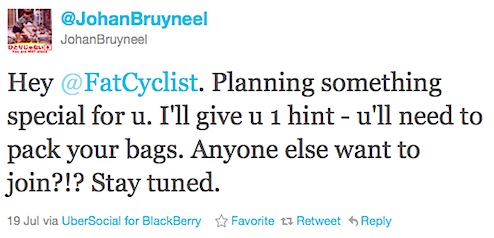
As you might expect, I was just a little bit intrigued. And then early this afternoon, while I was having some Twitter-free time, Johan posted this:

Yeah, as you can imagine, I didn’t waste a lot of time jumping over to the link, which I highly recommend you read, too.
No, it’s not an invitation to fill in for Chris Horner in the Tour de France, even though I’m roughly his height and have an identical hair style.
It’s an invitation for The Hammer and me to visit Africa to witness the good World Bicycle Relief (WBR) has done and is doing for children there — to watch how a bike can change a person’s life in very important ways.
And it’s also a challenge (Johan Bruyneel evidently loves to challenge people) to Team Fatty to raise enough money to buy 1000 bikes for kids there, with some amazing incentives to give you extra reasons to get on board.
I have to say: I’m amazed by this opportunity and challenge, and humbled, and very inspired.
And if we do this right, I’ll get to take one of you with me, and together we’ll put stickers on 1000 bikes, letting 1000 kids know that Team Fatty stepped up to help them.
Let’s go into some details, OK?
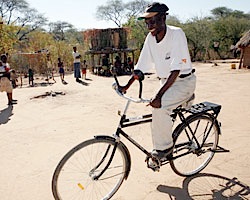 Why This Matters
Why This Matters
Before we talk about how the contest works and what you might win (and there is definitely some cool stuff to win!) by donating, let’s talk about why this contest is important to me, and why it should be important to you, too.
$134 is not a lot of money, but it will buy a good bicycle for a kid in Zambia. That bike will make it possible for the kid to make what would otherwise be a prohibitively long commute to school. Which means a kid that couldn’t otherwise stay in school, now can.
And that means new opportunities. And a better life.
Think about that for a sec: $134 can change a person’s life. Permanently, and in a big way.
Wow.
And Johan Bruyneel, along with his friends at WBR, are giving us the opportunity to change a thousand lives.
And to make it fun, he’s made it into a cool game: the more we raise, the more awesome prizes go into the drawing.
Let’s look at those for a minute.
Prize-ageddon
Those of you who know my contests know that I like to give away some cool stuff. In this case, though, the coolness level and quantity has gone so far through the roof that it’s in danger of passing out due to lack of oxygen.
Really.
The thing is, though, the more we raise, the more prizes there will be.
So, no matter what, we’ll be giving away WBR casual clothing and bike kits, Team RadioShack kits, a Team RadioShack jersey, cycling cap, and botttle signed by everyone still in the Tour, Road ID gift certificates, Giro Aeon helmets, Strider no-pedal bikes, and a set of HED Ardennes SL Wheels.
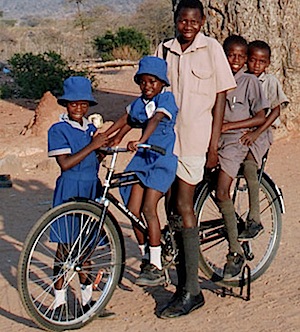 But as we raise enough money to buy certain numbers of bikes, increasingly mind-blowing prizes get added to the pot. Like this:
But as we raise enough money to buy certain numbers of bikes, increasingly mind-blowing prizes get added to the pot. Like this:
- 100 Bikes ($13,400): SRAM Red Pro Gruppo – SRAM’s top-of-the-top road group. And — if I may say so — darn near close to a work of art, appearance-wise. Win this and you’ll want to get a new frame, just to be worthy of the components. [UPDATE: We've already hit this goal!]
- 250 Bikes ($33,500): A Team RadioShack Trek Madone Bike (Race Ridden). You can’t look more pro than riding on a pro’s bike. Who’s bike will you get? Well, that depends on what size of bike you need. One thing’s for sure, though: it’s gonna be as light and sweet as UCI will allow. Oh, and the saddle will be nice and level, too. Ha.
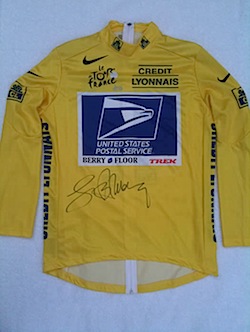 500 Bikes ($67,000): A yellow jersey, worn on the podium by Lance Armstrong in the Tour de France. Holy smokes, do you have any idea how much this thing is worth? Hint: enough that you might want to take good care of it.
500 Bikes ($67,000): A yellow jersey, worn on the podium by Lance Armstrong in the Tour de France. Holy smokes, do you have any idea how much this thing is worth? Hint: enough that you might want to take good care of it.- 750 Bikes ($100,500): Trek Travel 2012 Tour de France Paris Trip, with airfare and accommodations included. You haven’t ever wanted to go Paris and see the finish of the Tour de France, have you? No? Me either. Why would anyone want to do that? But you know what? If you win you can give the prize to me and I’ll go anyway, just so you won’t have to. That would be really nice of me.
- 1000 Bikes ($134,000): 1000 bikes. 1000 lives changed. When (not if!) we achieve this Grand Slam for Zambia, one of you will get to join The Hammer and me on a trip to Africa, where we’ll report back on how the work we’ve done together has changed lives. We’ll put “Grand Slam for Zambia” stickers on a thousand bikes. I’m told it’s going to be the experience of a lifetime, and I don’t doubt it.
Check Johan’s blog for more details on and photos of all these prizes, and I’ll be describing them in more detail soon, too.
And you know what? These aren’t even all the prizes there will be. I’ve got more good stuff lined up, and will be announcing them soon.
How the Contest Works
You can find the full version of the rules here, though if you have done my contests before you already understand how this one works. So if you want, just click on over and donate.
Anyway, here are the basics:
- Click here to go to the donation page.
- Donate any amount, but at least $5.00.
- For every $5.00 you donate, you get a chance at a prize.
- If you donate $134 — enough to buy a bike — you get a bonus 3 chances. (If you donate in multiples of $134, you get a bonus 3 chances for each 134 you donate).
- You have between now and August 27, Midnight (MT) to donate.
- We’ll notify the winners by email and phone.
Questions and Wrapup
Got any questions? Post them in comments. Don’t email me questions; I won’t see them. I’m currently so far behind on email I’m thinking of just deleting the whole 650+ (really) unread messages and starting over.
And a huge “thanks” goes out to Johan and the WBR folks for giving us this challenge. I am still trying to wrap my brain around it, but I am incredibly excited to do something so big and good with Team Fatty. And to have one of you come along to Africa with me to help tell the story of what Team Fatty is capable of accomplishing.
Comments (75)
07.19.2011 | 10:45 am
An [Updated] Note from Fatty: The pre-order for 2012 Fat Cyclist gear is now over. To everyone who ordered something: thank you very much.
Another Note from Fatty: For those unfamiliar with the Michael Smith saga, today’s piece may not make sense. I mean, even less sense than usual. So you may want to check out a much less opaque editorial here. And lots of details and a chronology with additional resources here.
News Flash: ESPN to Launch New Show: “That’s Hilarious!” With Michael Smith
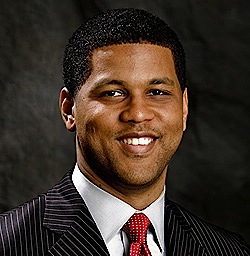 New York (Fat Cyclist Fake News Service) — ESPN, The Worldwide Leader in Sports™, announced today that it is launching a new daily TV series, hosted by popular ESPN anchor Michael Smith, called That’s Hilarious!
New York (Fat Cyclist Fake News Service) — ESPN, The Worldwide Leader in Sports™, announced today that it is launching a new daily TV series, hosted by popular ESPN anchor Michael Smith, called That’s Hilarious!
Said ESPN Spokesperson Deb “Tome” Forte, “This is a dangerous world, and terrible, tragic things happen every single day to completely innocent people.”
Continued Forte, “It’s time we have a TV show that laughs at those people.”
According to Forte, “Once in a lifetime — no, make that three lifetimes — the idea for a show reveals itself to us nearly fully-formed, with a perfect synergy of network relevance, human interest, and an anchor who was born for the job.”
Emphasized Forte, “That’s Hilarious! is just such a show.”
Genesis of a Genius Idea
The idea for the new television show came about quite by accident — literally — according to the host of the new show. “I was with my co-hosts of Around the Horn when we saw this bike race thingy. And — get this, ‘cuz it’s gonna just totally going to make you laugh your butt off — a car swipes one of the riders, causing him and another rider to crash and they both nearly die!“
Smith then broke into uncontrollable laughter for the next seven minutes.
“I’m sorry, I’m sorry. But that is just so funny,” said Smith between additional fits of giggles, tears streaming down his face. “I’m sorry, it’s just that that crash is hilarious. Every. Time.“
At this point, Smith relapsed into laughter, unable to speak.
“Do you see what we have here?” said Forte, smiling at Smith. “Michael Smith has a rare and wonderful gift. While most people would find Smith’s behavior psychotic and reprehensible,” continued Forte as she patted Smith on the head, “We at ESPN see an opportunity. An opportunity, specifically, to take the pain of others and treat it as if it were funny as hell.”
What Viewers Can Expect
In each episode of That’s Hilarious!, Michael Smith will show clips of human suffering. Smith will watch each clip several times, laughing as other people get hurt, always through no fault of their own.”
“That’s one of our gating criteria for showing a clip,” said Smith. “The person who gets hurt has to be just doing their thing. You know, like riding a bike in a race on a road. Or maybe waterskiing.”
“And then I’ll say something insightful that explains why it’s so funny, like, ‘For real, am I wrong for laughing at that? Can’t get over the driver speeding off as if he didn’t know he hit someone!’”
“Oh, sure, I know that the driver didn’t actually go speeding off, but if you just look at the ten-second clip I watch, then pretend nothing happens after that clip, well: pure comedy gold!”
“At least in early episodes, we’ll try to stick with sports as topics for Smith to laugh at,” said Forte. “But let’s face it, there’s a lot of stuff that happens to people who aren’t doing anything even remotely sport-related, and we want to give Michael the opportunity to laugh at them, too. And there are a lot of ways people can get hurt in this world that we don’t want to exclude. I mean, when someone sends us video of another guy getting bitten buy a shark or maimed in a construction accident, how can we in good conscience deprive Michael of the chance to laugh at those people too?”
“Anyway,” said Smith, wheezing and gasping, “after I laugh for a while, I’ll open up the phones and let people call in. I expect that people who are totally unfamiliar with the way the person in the clip got hurt will agree with me, and we’ll laugh together and probably watch the clip a couple more times, making fun of how stupid that person is for even being on a bike, or going waterskiing, or being a construction worker, or whatever.”
“After that,” said Forte, “We expect the offended calls to come in, with people saying things like, ‘Hey, I was out swimming and got my arm bitten off by a shark and I nearly died and it was terrifying and more incredibly painful than you can possibly imagine; how can you find that funny?’”
“Honestly,” continued Forte, “That’s when the real fun will begin. Smith will start by just baiting and taunting the callers. Then, once we’ve gotten enough calls, he’ll offer a few more taunts, and then maybe a fake apology.”
“We’ll then go to commercial break,” explained Smith, “After which instead of me, there’ll be a guy from legal, with his hand in a sock puppet that looks like me, and he’ll offer a carefully worded, stilted apology that nobody in their right minds would ever believe I would actually say.
“And then,” concluded Smith, “POOF! I’ll disappear! Just like magic.”
Co-hosted by Tony Kornheiser, That’s Hilarious! will air thrice daily daily on ESPN, ESPN2, ESPN3.com, ESPNU, ESPN Goal Line, ESPN Buzzer Beater, ESPN Classic, ESPN Xtreme, ESPN5, ESPN Radio, ESPN Kitchen, ESPN for Kidz, ESPN for Left-Handed People, and ESPN Estonia. Check your local listings for times.
Johnny Hoogerland was unavailable for comment, because he was too busy racing his bike several hours per day, with legs held together by about three spools of thread.
Comments (57)
« Previous Entries Next Page »
 OK, Now On With the Honey Stinger Love Fest
OK, Now On With the Honey Stinger Love Fest Honey Stinger Energy Chews
Honey Stinger Energy Chews Protein Bars
Protein Bars Energy Bars and Gels
Energy Bars and Gels
 The Law of Extremely Diminishing Returns
The Law of Extremely Diminishing Returns












 Why This Matters
Why This Matters But as we raise enough money to buy certain numbers of bikes, increasingly mind-blowing prizes get added to the pot. Like this:
But as we raise enough money to buy certain numbers of bikes, increasingly mind-blowing prizes get added to the pot. Like this: 500 Bikes ($67,000): A yellow jersey, worn on the podium by Lance Armstrong in the Tour de France. Holy smokes, do you have any idea how much this thing is worth? Hint: enough that you might want to take good care of it.
500 Bikes ($67,000): A yellow jersey, worn on the podium by Lance Armstrong in the Tour de France. Holy smokes, do you have any idea how much this thing is worth? Hint: enough that you might want to take good care of it. New York (
New York (